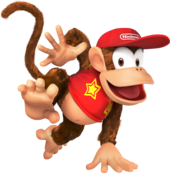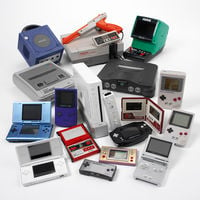Nintendo: Difference between revisions
m (Text replacement - "F-ZeroWiki" to "FZeroWiki") |
mNo edit summary |
||
| Line 57: | Line 57: | ||
==Home consoles== | ==Home consoles== | ||
[[File:Todas_las_consolas.jpg|thumb|right|A variety of Nintendo consoles.]] | [[File:Todas_las_consolas.jpg|thumb|right|A variety of Nintendo consoles and handhelds.]] | ||
*Color TV Game series (1977-1982) | *Color TV Game series (1977-1982) | ||
*[[Family Computer]] (1983 - 2003) / [[Nintendo Entertainment System]] (1985-1995) | *[[Family Computer]] (1983 - 2003) / [[Nintendo Entertainment System]] (1985-1995) | ||
Revision as of 00:17, December 7, 2019
- This article is about the Japanese company. For the console sometimes referred to as a Nintendo, see Nintendo Entertainment System. For the development team, see Nintendo Entertainment Analysis and Development.
Template:Company-infobox Nintendo (Japanese: 任天堂; Rōmaji: Nintendō) is a company in Japan which develops and manufactures its own line of video games and consoles. They are the creators of many popular series, including The Legend of Zelda, Pokémon, as well as their most popular series, the Mario franchise, plus many more. Nintendo's mascot is Mario himself. Nintendo is often credited with reviving the North American video game industry after the video game crash of 1983.
Currently, Nintendo's highest-selling home and handheld consoles are the Wii and Nintendo DS respectively.
History
The company was originally founded on September 23rd, 1889 by Fusajiro Yamauchi to produce handmade Hanafuda cards for use in a Japanese playing card game of the same name. Eventually, in 1929, the company was passed on to Yamauchi's son-in-law, Sekiryo Kaneda. He took up the Yamauchi name when he married Fusajiro's daughter, Tei Yamauchi. The company continued on to make Hanafuda cards. However, Kaneda decided to retire in 1949 and passed Nintendo down to his grandson, Hiroshi Yamauchi. Little did he know that Hiroshi would change the focus of Nintendo for the best. In the late '70s, Yamauchi decided to expand Nintendo into the United States, as arcade machines were becoming very popular. However, his plan did not go over as well as he had hoped. Many children in the U.S. did not show much interest in Nintendo's products, like Sheriff or Radar Scope. Nintendo started to lose money, so in desperation, Yamauchi turned to one of his employees, Shigeru Miyamoto, for help.
He called only Miyamoto in because he was the only employee who had any time on his hands. Yamauchi asked Miyamoto to make a product for the arcade machine that would become a best-seller. Shigeru Miyamoto worked on the project he was thinking of for a while: Donkey Kong. When it entered the North American market, it became a best-seller. Nintendo started moving into video games and assigned Gunpei Yokoi to make a handheld console for enjoyment while traveling. Thus, Yokoi made the Game & Watch, which became popular in both Japan and the United States. Nintendo then made the Nintendo Entertainment System, which grew very popular among children, the most successful game being Super Mario Bros. The release of the system forever changed the focus of video game development from quantity to quality and cemented the company's place in history. Aside from video games, Nintendo was also the majority owner of the Seattle Mariners, a Major League Baseball team from 1992 to 2016. In 2002, Hiroshi Yamauchi stepped down from office, giving the position to Satoru Iwata, who later became CEO of Nintendo's American branch and held both posts until his death in July 2015. After which, Tatsumi Kimishima was appointed Iwata's successor in September 2015, until he stepped down on June 28, 2018 and was succeeded by Shuntaro Furukawa.
Results of their work
Nintendo is the longest running company in the history of the video game console market and historically the most influential and best known console manufacturer. However, they do have business rivalry in Sony, Microsoft, and formerly their biggest rival, Sega (which is now reduced to third-party work). Nintendo, as a video game company, began in the Japanese market in 1983, the American market in 1985, and the European market in 1986. Over time Nintendo has manufactured seven TV consoles and nine handheld portables. They have also developed, and published over 300 games, and have sold over 2 billion games worldwide.
Nintendo has also sold very well among other consoles. Yamauchi, when he announced the Nintendo GameCube, stated that people do not buy a console for the console, they buy it for the game they want. He also believed that a video game console should be solely for video games, never anything else, in opposition to PlayStation 2's built-in DVD Player. These are the reasons why Nintendo's consoles are always the cheapest compared to other consoles.
All recent official Nintendo merchandise are marked with the Official Nintendo Seal. Originally, the seal was applied only to video games.
Some games sold so well that Nintendo made more prints under the labels Player's Choice and Nintendo Selects, under reduced prices.
Appearances in the Mario universe
- The WarioWare character 9-Volt calls himself "Nintendo's biggest fanboy," and his microgames are based on or around various Nintendo games and systems such as Dr. Mario and Donkey Kong.
- Diddy Kong's red cap has the Nintendo logo on it.
- Nintendo sponsors can be seen in the background of various Mario Kart courses and battle arenas.
- In the Mario Party series, the Nintendo logo, along with the Hudson Soft logo, appears on banners in various minigames.
- In Donkey Kong 64, Nintendo, along with Rareware, sponsors the boxing match between the Kongs and King K. Rool as mentioned by the Microbuffer.
- In Mario Power Tennis, the Nintendo logo appears on the Peach Dome court.
- In Mario Golf: Toadstool Tour and Mario Power Tennis, Wario holds up the Nintendo sign when the game boots up while stating the company's name, laughing.
- In Mario Hoops 3-on-3, the Nintendo logo, along with the Square Enix logo, appears on the arch next to the basket at Peach Field and on the banner and a large screen on the Mario Stadium court.
- In the Mario Baseball series, the Nintendo logo appears on some signs in Mario Stadium.
- In Mario Sports Mix, the Nintendo logo appears next to the sports equipment on the banners in Mario Stadium.
- In Mario Tennis Open, the Nintendo logo can be seen on the scoreboards in various courts.
Home consoles
- Color TV Game series (1977-1982)
- Family Computer (1983 - 2003) / Nintendo Entertainment System (1985-1995)
- Super Famicom (1990 - 2003) / Super Nintendo Entertainment System (1991-1999)
- Nintendo 64 (1996-2003)
- Nintendo GameCube (2001-2009)
- Wii (2006-2013)
- Wii U (2012-2017)
- Nintendo Switch1 (2017-present)
Attachments and remodels
- Family Computer Disk System (1986-1994)
- Satellaview (1995-2000)
- Nintendo 64DD (1999-2001)
- Wii Family Edition (2011-2013)
- Wii Mini (2012-2017)
These consoles may have different names in different markets. The NES is known as Famicom in Japan, the SNES subsequently as Super Famicom. In China, the Nintendo 64 was released under the name iQue Player.
1 - Although the Nintendo Switch can also function as a handheld console, it is primarily marketed as a home console by Nintendo.
Handheld consoles
- Game & Watch (1980-1991)
- Game Boy (1989-2003)
- Virtual Boy (1995-1996)
- Game Boy Color (1998-2003)
- Game Boy Advance (2001-2009)
- Nintendo DS (2004-2013)
- Nintendo 3DS (2011-present)
Remodels
- Game Boy Play it Loud (1996)
- Game Boy Pocket (1996-1998)
- Game Boy Light (1997-2003)
- Game Boy Advance SP (2003-2009)
- Game Boy Micro (2005-2009)
- Nintendo DS Lite (2006-2011)
- Nintendo DSi (2008-2013)
- Nintendo DSi XL (2009-2013)
- Nintendo 3DS XL (2012-2015)
- Nintendo 2DS (2013-present)
- New Nintendo 3DS (2014-present)
- New Nintendo 3DS XL (2014-present)
- New Nintendo 2DS XL (2017-present)
- Nintendo Switch Lite (2019-present)
Releases of these consoles in China usually replace "Nintendo" in the name with "iQue". Examples are the iQue DS and the iQue 3DS XL.
Gallery
Sprite of a Nintendo logo variant, from Diddy Kong Racing DS
The gold Nintendo logo from the start-up of Mario Kart 64
See also
- Shigeru Miyamoto
- Satoru Iwata
- Hiroshi Yamauchi
- Yoshiaki Koizumi
- Tatsumi Kimishima
- Koji Kondo
- Gunpei Yokoi
- Reggie Fils-Aimé
- Doug Bowser
Names in other languages
| Language | Name | Meaning | Notes |
|---|---|---|---|
| Japanese | 任天堂 ニンテンドー[?] Nintendō |
任天堂 is the formal name of the company. For each characters, 任 (nin) means "responsibility", "work" or "obligation", 天 (ten) means "sky" and 堂 (dō ) meaning "stately", "bless" or "sanctuary". Also 天堂 (tendō ) means "heaven". ニンテンドー is written in rough katakana form and is used for the Japanese names of some Nintendo's consoles, like Nintendo GameCube (ニンテンドーゲームキューブ, Nintendō Gēmukyūbu). The name Nintendo comes from a Japanese saying, 「運を天に任せる」(un o ten ni makaseru), meaning "To leave one's luck to heaven." |
|
| Chinese | 任天堂[?] Rèntiāntáng |
? | |
| Korean | 닌텐도[?] Nintendo |
? |
Trivia
- Nintendo licensed Laral Group LLC to make a joystick controller for personal computers called the NJS-3D1. It was released in July of 1997 and it was one of only two Nintendo-licensed products by Laral, the other being the Nintendo wireless infrared stereo headphone system.[1]
External links
- Official Japanese website
- Official American website
- Official Canadian (English) website
- Official Canadian (French) website
- Official Latin American website
- Official Brazilian website
- Official Colombian website
- Official Argentinian website
- Official Chilean website
- Official Peruvian website
- Official European website
- Official Danish website
- Official Finnish website
- Official Norwegian website
- Official Swedish website
- Official Hungarian website
- Official Polish website
- Official Czech website
- Official Slovak website
- Official Oceanian website
- Official Korean website
- Official Hong Kongese website
- Official Taiwanese website


